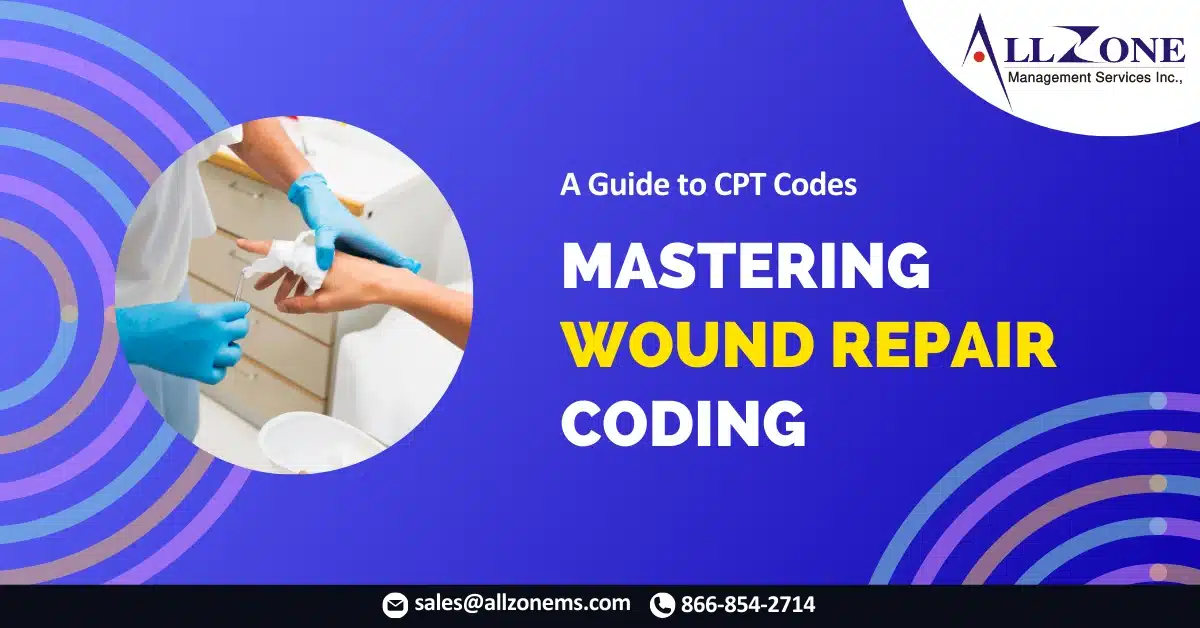To correctly code for wound repair, three crucial details must be identified in the clinical documentation:
-
- Complexity of the Repair – Simple, intermediate, or complex
- Anatomic Location – Specific body area where the wound is closed
- Wound Length – Measured in centimeters
Each of these elements is essential for proper code selection. Wound repairs can involve sutures, staples, or tissue adhesive (e.g., Dermabond) alone or in combination. However, if adhesive strips are the sole method of closure, the appropriate Evaluation & Management (E/M) code should be reported instead. For Medicare claims, wounds closed exclusively with tissue adhesives like Dermabond are reported using HCPCS Level II code G0168, while commercial payers allow the use of simple repair codes (12001-12018).
Let’s break down the three key factors in coding wound repair correctly.
1. Determine Repair Complexity
CPT® classifies wound repairs into three categories:
Simple Repairs (12001-12021)
-
-
- Used for superficial wounds involving the epidermis, dermis, or subcutaneous tissue
- No deeper structures (e.g., muscle) involved
- Typically one-layer closure
- Includes local anesthesia and chemical/electro-cauterization
-
Intermediate Repairs (12031-12057)
-
-
- Require layered closure of subcutaneous tissue and superficial fascia
- Deeper or gaping wounds that need sutures inside the wound
- Extensive wound cleaning or decontamination qualifies as intermediate repair
-
Complex Repairs (13100-13160)
-
-
- Involve extensive techniques like debridement, stents, scar revision, or retention sutures
- May require creation of a defect for repair
- Used for treating complicated avulsions or lacerations
-
Key Documentation Clues:
-
-
- Terms like “layered closure”, “extensive cleaning”, or “removal of debris” indicate intermediate repair
- Mention of “single-layer closure” suggests a simple repair
- Documentation of “extensive reconstructive repair” signals a complex repair
-
2. Identify the Anatomic Location
Each level of repair is further classified by anatomic location:
Simple Repairs
-
- 12001-12007: Scalp, neck, axillae, external genitalia, trunk, extremities (hands/feet included)
- 12011-12015: Face, ears, eyelids, nose, lips, mucous membranes
Intermediate Repairs
-
- 12031-12037: Scalp, axillae, trunk, extremities (excluding hands/feet)
- 12041-12047: Neck, hands, feet, external genitalia
- 12051-12057: Face, ears, eyelids, nose, lips, mucous membranes
Complex Repairs
-
- 13100-13102: Trunk
- 13120-13122: Scalp, arms, legs
- 13131-13133: Forehead, cheeks, chin, mouth, neck, axillae, genitalia, hands, feet
- 13151-13153: Eyelids, nose, ears, lips
3. Measure and Report Wound Length
The final step in selecting the correct code is measuring the wound length. This must be recorded in centimeters, regardless of the wound shape (curved, angular, or stellate). If documentation uses inches or millimeters, convert to centimeters before assigning a code.
Coding Multiple Wound Repairs
When multiple wounds are repaired during a session:
- Same complexity & anatomic area? Add the wound lengths together and report with a single cumulative code
- Different complexity or location? Report the most extensive repair as primary and append modifier 59 to additional codes
Note: Multiple procedure reductions apply to the second and subsequent repair codes unless an add-on code is used.
Bundling Rules: When Can You Report Additional Services?
Some related procedures cannot be separately reported, while others may or must be billed separately.
Never Reported Separately with Wound Repair
-
- Services included in the global surgical package (e.g., local anesthesia, postop care)
- Chemical or electro-cauterization
- Simple ligation of vessels
- Basic wound exploration (deeper exploration may be separately reported)
- Debridement for complex repairs (considered part of the procedure)
Sometimes Reported Separately
-
- Debridement & decontamination
- Only report separately if extensive cleansing or devitalized tissue removal is documented
- Lesion excision
- Simple closure is bundled
- Intermediate or complex closure should be coded separately
- Debridement & decontamination
Always Reported Separately
-
- Excisional wound bed preparation
- Debridement for open fractures/dislocations
- Complex repair of nerves, blood vessels, tendons
- Exploration beyond simple inspection
- Use CPT® codes 20100-20103 for extended dissection, removal of foreign bodies, or vascular ligation
Key Takeaways for Accurate Wound Repair Coding
-
- Identify the repair complexity (simple, intermediate, or complex)
- Determine the anatomic location of the wound
- Measure the wound length in centimeters
- Follow bundling guidelines for related procedures
Accurate documentation ensures coding precision, compliance, and proper reimbursement. Master these fundamentals and you’ll be well-equipped to navigate wound repair coding with confidence.
Wound Repair Coding & Specialty Billing Services
Accurate medical coding is essential for maximizing reimbursement and ensuring compliance in wound repair procedures. Our Wound Repair Coding Services ensure precise documentation and correct CPT code selection for simple, intermediate, and complex wound closures.
Beyond wound care, we specialize in comprehensive specialty billing services covering cardiology, radiology, orthopedics, dermatology, anesthesiology, and more. Our team of certified coders and billing experts ensures accurate claim submissions, denial management, and optimized revenue cycle management (RCM).
By outsourcing your wound repair coding and specialty billing, you can reduce administrative burdens, improve cash flow, and enhance compliance. Whether you’re a solo practitioner, a multi-specialty clinic, or a hospital, our tailored medical billing solutions help streamline your operations and maximize revenue.
Let us handle your medical coding and billing challenges so you can focus on patient care! Contact us today.

